
Once it a while, I come across a site that strikes me as so magnificent and mysterious that I wonder why I didn’t know about it before, why it’s not spoken of by everyone with an inclination to ancient history.
If you’ve been reading my blogs you’ll know that I love to travel and have done so quite a bit in Greece. A few years ago, I was touring some of the major sites with friends and family – Delphi, Mycenae, Olympia etc. The biggies.
After Olympia, we drove back into the mountains of the Peloponnese. It was hot and bright, and the cicadas were whirring louder than I had ever heard before. As I was navigating a particularly treacherous series of mountain switchbacks, my father-in-law said that we should go south to Bassae.
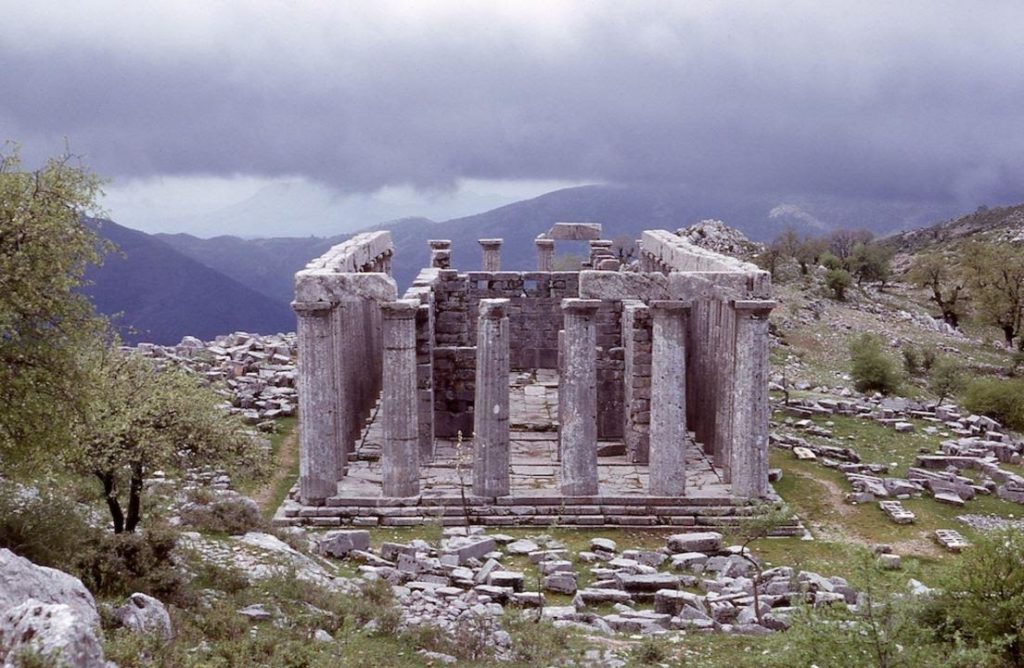
Temple of Bassae in 1966 (McGill University archive)
“Bassae?” I said. “What’s there?”
“Some ruins,” he answered. “There is a temple of Apollo Epikourios.”
“Apollo Epi-what?” I half-answered, too focussed on the road to pronounce this new, strange word.
Admittedly my first thought was of Apicius and food – no matter that the Roman gourmet was about a six hundred or so years off. I was also starving at that moment!
So we turned south, into the teeth of even larger mountains.
Apollo Epikourios means ‘Apollo the Succourer’ or ‘Apollo the Helper’.

Plan of Bassae temple (Wikimedia Commons)
The epithet refers to Apollo’s role as a god of healing.
In the mid-seventh century B.C., Spartan warriors and plague came to the people of Phigaleia who were living in these high mountains. Many offerings in the form of weapons were found on site indicating that originally, in this place, Apollo was worshipped as a martial god. However, after escaping Spartan aggression and the plague of later years, Apollo became a ‘succourer’ or helper to the Phigalians.
In gratitude, the Phigalians commissioned the architect Ictinus to build the temple at Bassae.
This was no small thing. In Classical Greece, Ictinus was an A-list architect – he was one of the architects of the Parthenon and the great Temple of Mysteries at Eleusis.
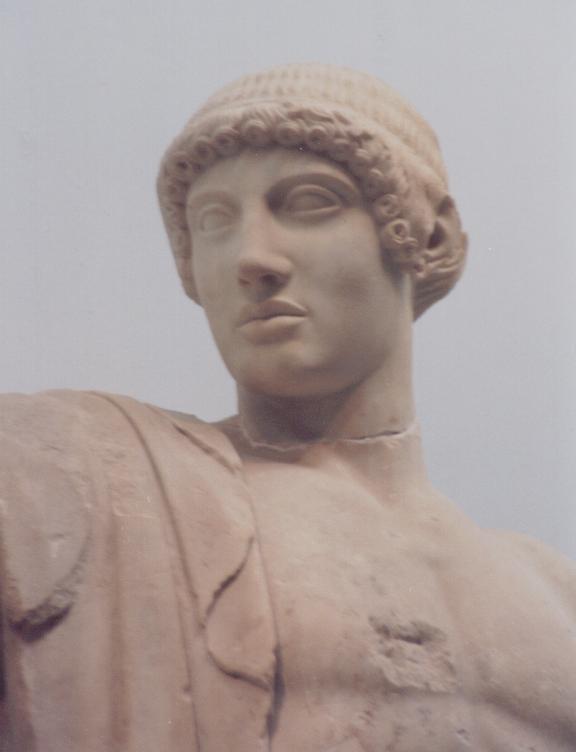
Apollo
In the second century A.D. Pausanias visited Bassae and the temple there:
“Phigalia is surrounded by mountains, on the left by Mount Cotilius, while on the right it is sheltered by Mount Elaius. Mount Cotilius is distant about forty furlongs from the city: on it is a place called Bassae, and the temple of Apollo the Succourer, built of stone, roof and all. Of all the temples in the Peloponnese, next to the one at Tegea, this may be placed first for the beauty of the stone and the symmetry of its proportions. Apollo got the name of Succourer for the succour he gave in time of plague, just as at Athens he received the surname of Averter of Evil for delivering Athens also from the plague. It was at the time of the war between the Peloponnesians and the Athenians that he delivered the Phigalians also, and at no other time: This is proved by his two surnames, which mean much the same thing, as well by the fact that Ictinus, the architect of the temple at Phigalia, was a contemporary of Pericles, and built for the Athenians the Parthenon, as it is called.” (Pausanias)
When most tourists visit the Peloponnese today, they focus on sites like Mycenae, Epidaurus, ancient Corinth, and of course, Olympia. Why wouldn’t folks head for these places? They are magnificent sites that are all worth visiting – more than once.
However, if you are more adventurous and enjoy heading off the beaten path, the Peloponnese holds some hidden treasures that are not always prominently featured in guidebooks or on tour itineraries.
Bassae, a UNESCO World Heritage Site, is one of those special, unsung places. Academics know about it but few tourists make it there. In fact, due to its remote location, it lay mostly forgotten until the early nineteenth century.
Our car whined up the steep mountain, higher and higher, the sunlight blinding. I felt like Icarus for a moment, driving up and up.
We finally levelled out and our eyes were met by a giant, white…tent.
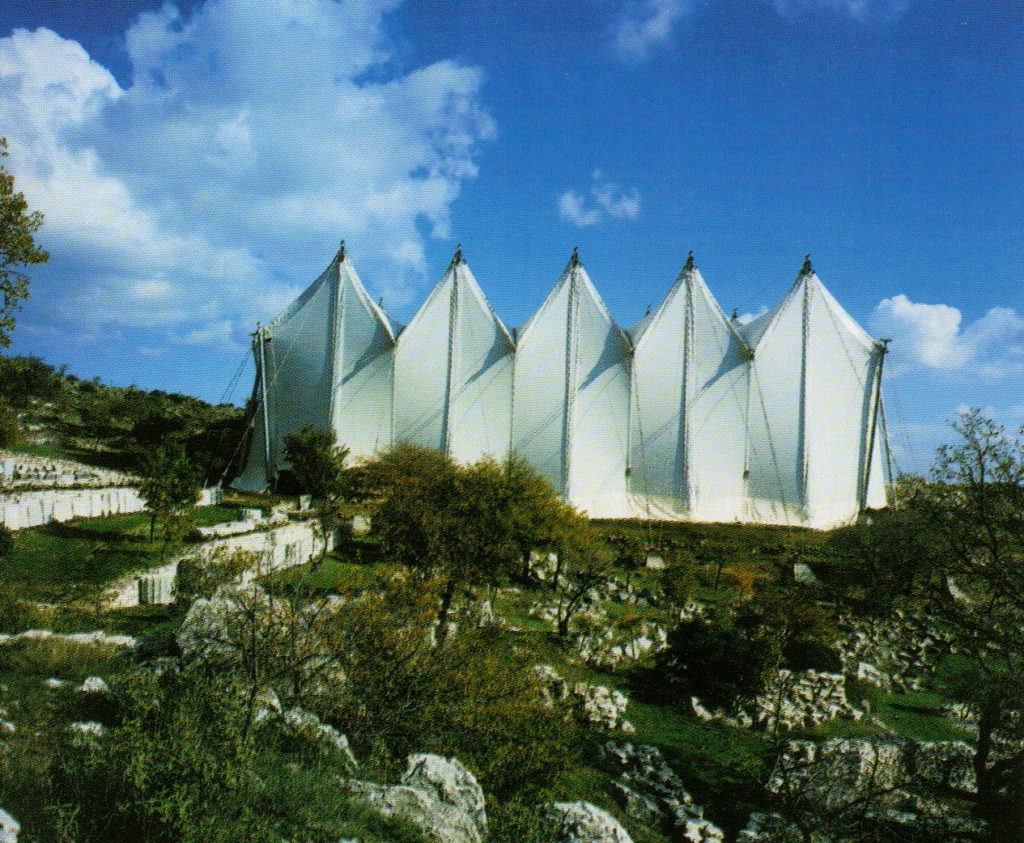
The ‘tent’ covering the temple at Bassae
“This is weird,” I remembered saying. I had no idea what lay beneath the white, sail barge structure.
We paid our minimal entry fee to the lady in the wooden site booth; she sat smoking and sipping an hours-old café frappé.
The mountain top was rocky and desolate, patched with hardy olive trees and shrubs. We made our way up the rocky path to the tent and stepped beneath the awning.
I couldn’t believe my eyes.
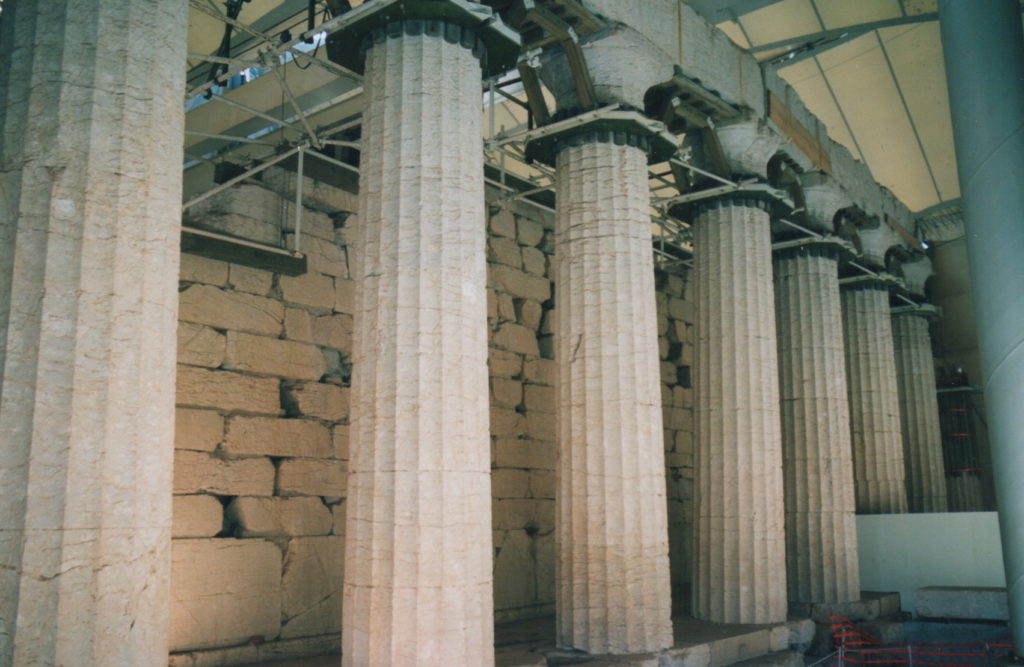
Doric columns in front of temple wall
Up there, at what felt like the top of the world, was a magnificent stone temple, one of the most complete temples I had ever seen. The stone was cracked in many places, pounded by the elements for centuries in its eyrie.
But it was intact, columns and walls, foundations. A few stray rays of sunlight made their way into the shaded sanctum to illuminate the cella. We were the only visitors on site, and the main sense that invaded my person was pure awe.
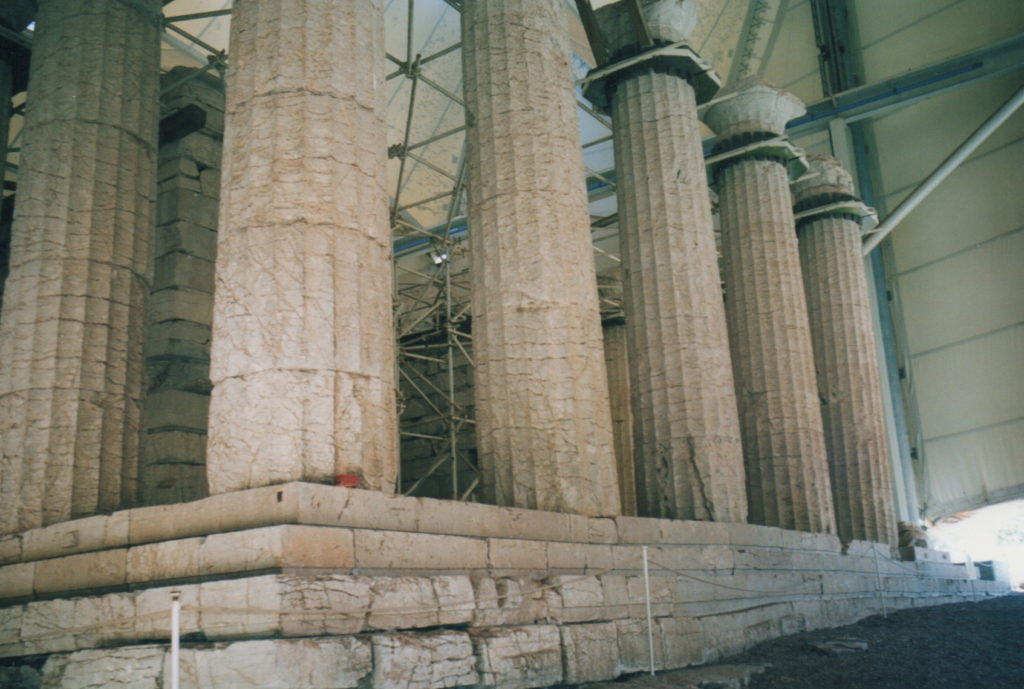
Steps leading up to temple platform
Bassae’s Temple of Apollo is a particularly important specimen, and not just because of the architect. It contained the earliest known example of a Corinthian capital which was displayed in the middle of the naos which was lined with Ionic columns. However, on the outside of the temple, the strength and support of the structure is provided by strong Doric columns, fifteen on each long side and six on the ends.
One of the things that make this temple unique is the incorporation of all three of the classical orders of columns. Also, the interior of the cella was ornamented with a series of beautifully detailed friezes of the Amazonomachy (Battle of the Amazons) and the Battle Centaurs and Lapiths.

Fanciful reconstruction of Bassae interior by Charles Cockerell (Wikimedia Commons)
You can see the Bassae Friezes at the British Museum where they are on display, far from their home at the top of that lonely mountain.
I think I was in such awed shock the first time that I didn’t quite realize what I was looking at.
Some places do that to you. The power of the place and setting can quite overwhelm the academic eye.

Amazonomachy – Bassae Frieze
After wandering around the temple for a time, we went back outside into the sun to look at the surrounding countryside. These were some of the highest mountains in the Peloponnese and they stretched out in all directions. It is a quiet, contemplative atmosphere.
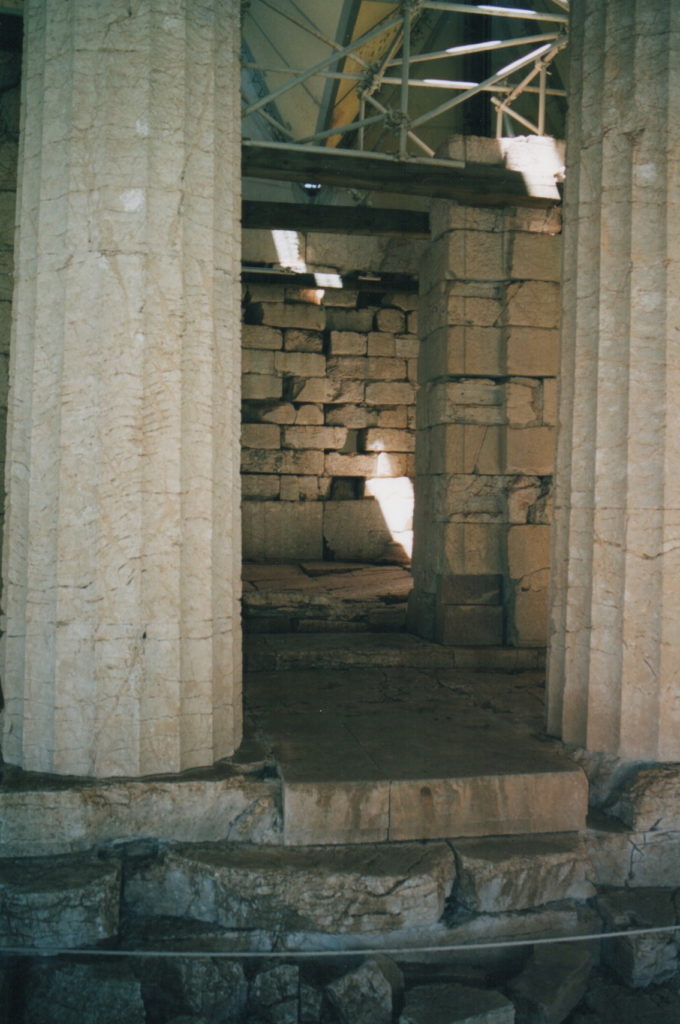
Sunlight filtering into the cella of the temple
Outside the cicadas were louder than ever, but it is a sound I have come to associate with peace. The air was hot but dry and tinged with wild thyme that must once have been laid upon Apollo’s altar by the Phigalians.
We stood in the sun and looked to Mount Kotilon where the map indicated that there was a Temple to Aphrodite and another to Artemis Orthasia, the ‘Protector of Small Children’.
These mountains are a place for gods.
I hope, one day, to return to Bassae. I want to circle the Temple of Apollo Epikourios and to remember the Phigalians who thanked him for his aid by building him this magnificent sanctuary in the sky.

* A useful source on the temple of Apollo Epikourios is:



